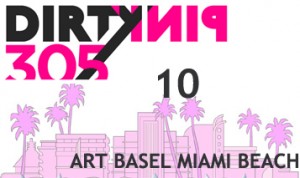With Art Basel Miami Beach only two weeks away, we are all holding our breath in anticipation of the flurry of events that will be taking place throughout South Beach and the “mainland” of Miami.
The scramble will be on to find that seminal art piece, the most sought-after event to attend, the best opportunities to shoulder-rub. But how much is Miami’s art community impacted by the networking that takes place when the globe arrives on its doorstep?
From our interviews, it is evident that opportunities do arise from visitors coming to Miami. Artists have received exhibition opportunities, and there has been an increased interest in including Miami artists in major US survey exhibitions. A few years back, then-Whitney Museum curator Shamim Momin traveled to Miami in search of artists with Biennale potential, and Hans Ulrich Obrist selected several Miami artists for his group show Uncertain States of America. Yet how do we quantify the effect these opportunities have had on an artist’s career over the long term?
Who better to answer this question than the artists themselves? I have selected three artist quotes from Dirty Pink 305’s interviews that best describe what these opportunities have meant to them and to their artistic practice, going forward.
“And then again, another really great project based from here from a connection was to go and do a project through the Uncertain States of America exhibition in Denmark. So that in itself is amazing, to have the opportunity to showcase your work on an international platform. It gives you a completely different set of eyes on your work, a different critique, a different assessment, even for myself when I came back. How is my work being read [by others], by someone else who is speaking a different language; aesthetics are different. I think that led to a lot of the idea of shifting in my work to become a little bit more universally recognizable, and recognizing that artists, by physically being sequestered to a local area and just doing things locally, you can become very esoteric or very single-minded from where you are.”
TM Sisters (Monica and Natasha Lopez de Victoria)
Natasha: “…people happen to be in town, and different people spread the word in different ways, and different people that were in town saw stuff that way, just through the love of the family….”
Monica: “And yeah, specifically that Hans Ulrich Obrist picked us for the big Uncertain States of America exhibition and the way that came about was, we had done a collaborative show with a bunch of the Miami artists and everyone worked with each other, it was more about the process, we didn’t care about the end result. So it was a big exhibition, and someone had told him to go see this show, and I think it was locked up, and Bhakti (Baxter) happened to be passing by and have the key, and so he was able to let [Obrist] in and he saw a bunch of the artists that he ended up choosing from Miami from that show. So that helped us get more internationally out there, by him picking our work for this touring.”
“I think that it allowed working artists to seriously to get a lot of attention, and for me, it really allowed me to make a lot of connections nationally. A lot of people came through that were amazing, like early on Jeffrey Deitch came to see my studio behind my grandmother’s house, and a cab driver took him there, he drove for an hour and came to see my work. A lot of things like that happened because I think it was the moment, and it was really good timing.”
From these quotes we can deduce that the attention focused on Miami has impacted these specific artists in a very positive fashion.
The questions that immediately need to follow:
- Is this impact sustainable?
- What happens to artists working outside the paradigm of “American” exhibitions?
- How long would this attention last if Art Basel Miami Beach were to, say, move to Los Angeles?
In celebration of the 10th anniversary of Art Basel Miami Beach, we are sure to see many attempts at writing its history, most likely in relation to Miami as a city, and even more likely depicting the Miami art community from a skewed vantage point that only describes practices in relation to the art fair and the art market paradigm. Of course we should hope for a different outcome.
Dirty Pink 305 provides a resource for future writings about Miami contemporary art that includes the voice of artists. In the words of Adler Guerrier:
“I think the larger PR machine of Art Basel kind of rephrased [the Miami art scene], for it to be more institution and collector led. But I’m going to say that really hasn’t really been the case, they lead by virtue of the fact that they are an institution and they’re collectors, but it’s only by virtue of being, you know, true leaders. I think they reflect what we do. So I think that’s Miami.”
